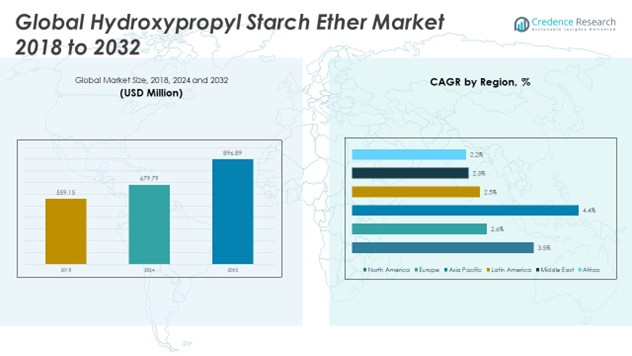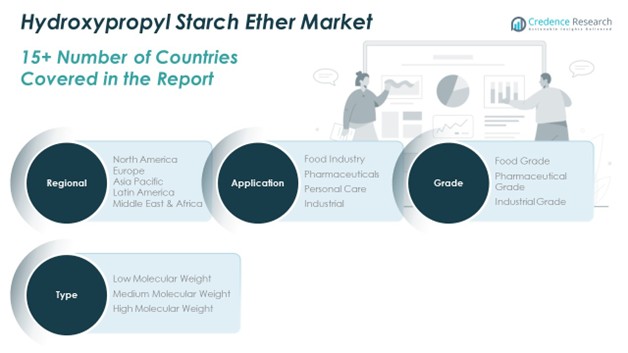CHAPTER NO. 1 : GENESIS OF THE MARKET
1.1 Market Prelude – Introduction & Scope
1.2 The Big Picture – Objectives & Vision
1.3 Strategic Edge – Unique Value Proposition
1.4 Stakeholder Compass – Key Beneficiaries
CHAPTER NO. 2 : EXECUTIVE LENS
2.1 Pulse of the Industry – Market Snapshot
2.2 Growth Arc – Revenue Projections (USD Million)
2.3. Premium Insights – Based on Primary Interviews
CHAPTER NO. 3: HYDROXYPROPYL STARCH ETHER MARKET FORCES & INDUSTRY PULSE
3.1 Foundations of Change – Market Overview
3.2 Catalysts of Expansion – Key Market Drivers
3.2.1 Momentum Boosters – Growth Triggers
3.2.2 Innovation Fuel – Disruptive Technologies
3.3 Headwinds & Crosswinds – Market Restraints
3.3.1 Regulatory Tides – Compliance Challenges
3.3.2 Economic Frictions – Inflationary Pressures
3.4 Untapped Horizons – Growth Potential & Opportunities
3.5 Strategic Navigation – Industry Frameworks
3.5.1 Market Equilibrium – Porter’s Five Forces
3.5.2 Ecosystem Dynamics – Value Chain Analysis
3.5.3 Macro Forces – PESTEL Breakdown
3.6 Price Trend Analysis
3.6.1 Regional Price Trend
3.6.2 Price Trend by product
CHAPTER NO. 4 : KEY INVESTMENT EPICENTER
4.1 Regional Goldmines – High-Growth Geographies
4.2 Product Frontiers – Lucrative Product Categories
4.3 Grade Sweet Spots – Emerging Demand Segments
CHAPTER NO. 5: REVENUE TRAJECTORY & WEALTH MAPPING
5.1 Momentum Metrics – Forecast & Growth Curves
5.2 Regional Revenue Footprint – Market Share Insights
5.3 Segmental Wealth Flow – Application & Grade Revenue
CHAPTER NO. 6 : TRADE & COMMERCE ANALYSIS
6.1.Import Analysis by Region
6.1.1. Global Hydroxypropyl Starch Ether Market Import Revenue By Region
6.2.Export Analysis by Region
6.2.1. Global Hydroxypropyl Starch Ether Market Export Revenue By Region
CHAPTER NO. 7 : COMPETITION ANALYSIS
7.1.Company Market Share Analysis
7.1.1. Global Hydroxypropyl Starch Ether Market: Company Market Share
7.2. Global Hydroxypropyl Starch Ether Market Company Revenue Market Share
7.3.Strategic Developments
7.3.1.Acquisitions & Mergers
7.3.2. New Product Launch
7.3.3. Regional Expansion
7.4. Competitive Dashboard
7.5. Company Assessment Metrics, 2024
CHAPTER NO. 8: HYDROXYPROPYL STARCH ETHER MARKET – BY APPLICATION SEGMENT ANALYSIS
8.1.Hydroxypropyl Starch Ether Market Overview by Application Segment
8.1.1. Hydroxypropyl Starch Ether Market Revenue Share By Application
8.2. Food Industry
8.3. Pharmaceuticals
8.4. Personal Care
8.5. Industrial
CHAPTER NO. 9: HYDROXYPROPYL STARCH ETHER MARKET – BY GRADE SEGMENT ANALYSIS
9.1.Hydroxypropyl Starch Ether Market Overview by Grade Segment
9.1.1. Hydroxypropyl Starch Ether Market Revenue Share By Grade
9.2. Food Grade
9.3. Pharmaceutical Grade
9.4. Industrial Grade
CHAPTER NO. 10: HYDROXYPROPYL STARCH ETHER MARKET – BY TYPE SEGMENT ANALYSIS
10.1.Hydroxypropyl Starch Ether Market Overview by Type Segment
10.1.1. Hydroxypropyl Starch Ether Market Revenue Share By Type
10.2. Low Molecular Weight
10.3. Medium Molecular Weight
10.4. High Molecular Weight
CHAPTER NO. 11: HYDROXYPROPYL STARCH ETHER MARKET – REGIONAL ANALYSIS
11.1.Hydroxypropyl Starch Ether Market Overview by Region Segment
11.1.1. Global Hydroxypropyl Starch Ether Market Revenue Share By Region
11.1.3.Regions
11.1.4.Global Hydroxypropyl Starch Ether Market Revenue By Region
.1.6.Application
11.1.7.Global Hydroxypropyl Starch Ether Market Revenue By Application
11.1.9.Grade
11.1.10. Global Hydroxypropyl Starch Ether Market Revenue By Grade
11.1.12. Type
11.1.13. Global Hydroxypropyl Starch Ether Market Revenue By Type
CHAPTER NO. 12: NORTH AMERICA HYDROXYPROPYL STARCH ETHER MARKET – COUNTRY ANALYSIS
12.1.North America Hydroxypropyl Starch Ether Market Overview by Country Segment
12.1.1.North America Hydroxypropyl Starch Ether Market Revenue Share By Region
12.2.North America
12.2.1.North America Hydroxypropyl Starch Ether Market Revenue By Country
12.2.2.Application
12.2.3.North America Hydroxypropyl Starch Ether Market Revenue By Application
12.2.4.Grade
12.2.5.North America Hydroxypropyl Starch Ether Market Revenue By Grade
2.2.6.Type
12.2.7.North America Hydroxypropyl Starch Ether Market Revenue By Type
2.3.U.S.
12.4.Canada
12.5.Mexico
CHAPTER NO. 13: EUROPE HYDROXYPROPYL STARCH ETHER MARKET – COUNTRY ANALYSIS
13.1. Europe Hydroxypropyl Starch Ether Market Overview by Country Segment
13.1.1. Europe Hydroxypropyl Starch Ether Market Revenue Share By Region
13.2.Europe
13.2.1.Europe Hydroxypropyl Starch Ether Market Revenue By Country
13.2.2.Application
13.2.3.Europe Hydroxypropyl Starch Ether Market Revenue By Application
13.2.4.Grade
13.2.5. Europe Hydroxypropyl Starch Ether Market Revenue By Grade
13.2.6.Type
13.2.7. Europe Hydroxypropyl Starch Ether Market Revenue By Type
13.3.UK
13.4.France
13.5.Germany
13.6.Italy
13.7.Spain
13.8.Russia
13.9. Rest of Europe
CHAPTER NO. 14: ASIA PACIFIC HYDROXYPROPYL STARCH ETHER MARKET – COUNTRY ANALYSIS
14.1.Asia Pacific Hydroxypropyl Starch Ether Market Overview by Country Segment
14.1.1.Asia Pacific Hydroxypropyl Starch Ether Market Revenue Share By Region
14.2.Asia Pacific
14.2.1. Asia Pacific Hydroxypropyl Starch Ether Market Revenue By Country
14.2.2.Application
14.2.3.Asia Pacific Hydroxypropyl Starch Ether Market Revenue By Application
14.2.4.Grade
14.2.5.Asia Pacific Hydroxypropyl Starch Ether Market Revenue By Grade
14.2.5.Type
14.2.7.Asia Pacific Hydroxypropyl Starch Ether Market Revenue By Type
14.3.China
14.4.Japan
14.5.South Korea
14.6.India
14.7.Australia
14.8.Southeast Asia
14.9. Rest of Asia Pacific
CHAPTER NO. 15: LATIN AMERICA HYDROXYPROPYL STARCH ETHER MARKET – COUNTRY ANALYSIS
15.1.Latin America Hydroxypropyl Starch Ether Market Overview by Country Segment
15.1.1.Latin America Hydroxypropyl Starch Ether Market Revenue Share By Region
15.2. Latin America
15.2.1. Latin America Hydroxypropyl Starch Ether Market Revenue By Country
15.2.2.Application
15.2.3. Latin America Hydroxypropyl Starch Ether Market Revenue By Application
15.2.4.Grade
15.2.5.Latin America Hydroxypropyl Starch Ether Market Revenue By Grade
15.2.6.Type
15.2.7.Latin America Hydroxypropyl Starch Ether Market Revenue By Type
15.3.Brazil
15.4.Argentina
15.5.Rest of Latin America
CHAPTER NO. 16: MIDDLE EAST HYDROXYPROPYL STARCH ETHER MARKET – COUNTRY ANALYSIS
16.1.Middle East Hydroxypropyl Starch Ether Market Overview by Country Segment
16.1.1.Middle East Hydroxypropyl Starch Ether Market Revenue Share By Region
16.2.Middle East
16.2.1. Middle East Hydroxypropyl Starch Ether Market Revenue By Country
16.2.2.Application
16.2.3.Middle East Hydroxypropyl Starch Ether Market Revenue By Application
16.2.4.Grade
16.2.5.Middle East Hydroxypropyl Starch Ether Market Revenue By Grade
16.2.6. Type
16.2.7.Middle East Hydroxypropyl Starch Ether Market Revenue By Type
16.3.GCC Countries
16.4. Israel
16.5. Turkey
16.6.Rest of Middle East
CHAPTER NO. 17: AFRICA HYDROXYPROPYL STARCH ETHER MARKET – COUNTRY ANALYSIS
17.1. Africa Hydroxypropyl Starch Ether Market Overview by Country Segment
17.1.1.Africa Hydroxypropyl Starch Ether Market Revenue Share By Region
17.2. Africa
17.2.1.Africa Hydroxypropyl Starch Ether Market Revenue By Country
17.2.2.Application
17.2.3.Africa Hydroxypropyl Starch Ether Market Revenue By Application
17.2.4.Grade
17.2.5. Africa Hydroxypropyl Starch Ether Market Revenue By Grade
17.2.6.Type
17.2.7. Africa Hydroxypropyl Starch Ether Market Revenue By Type
17.3. South Africa
17.4.Egypt
17.5.Rest of Africa
CHAPTER NO. 18 : COMPANY PROFILES
18.1. Cargill, Incorporated
18.1.1.Company Overview
18.1.2.Product Portfolio
18.1.3.Financial Overview
18.1.4.Recent Developments
18.1.5.Growth Strategy
18.1.6.SWOT Analysis
18.2. LOTTE Chemical Corporation
18.3. Fenchem
18.4.Xiwang Group
18.5. Zhucheng Xingmao Starch
18.6. Shouguang Hongyuan Bioengineering
18.7. Ashland
18.8. Ingredion Incorporated
18.9. Puyang Jincheng Group
18.10. Emsland Group
18.11. BioChem Technology Group Company Limited
18.12. Dow
18.13. Tate Lyle PLC
18.14. Archer Daniels Midland Company





